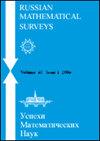Valerii Vasil’evich Kozlov
IF 2.1
4区 数学
Q1 MATHEMATICS
引用次数: 0
Abstract
On 1 January 2020 the prominent researcher and academician of the Russian Academy of Sciences Valerii Vasil’evich Kozlov observed his 70th birthday. Kozlov has made fundamental contributions to diverse areas of mathematics and mechanics: the theory of Hamiltonian systems, stability theory, the mechanics of non-holonomic systems, statistical mechanics. He has published about 300 papers on mathematics and mechanics and 8 monographs which are now classical. In this one article it is impossible to give even a brief account of all the directions of his research. Kozlov was born on 1 January 1950 in the village of Kostyli, in the Mikhailovskoe District of the Ryazan Oblast. His mother Ol’ga Arkhipovna was a teacher of mathematics, and his father Vasilii Nestorovich was a train-driver, and a veteran of World War II, from the first days when the Soviet Union was attacked until Victory Day. Valerii started his early school education in his native small village (where nobody lives now). There was only a primary school there, with one female teacher, who gave simultaneous lessons to grades I and III in the morning and to grades II and IV in the afternoon. As an 8-year boy, Kozlov moved with his parents to Lyublino-Dachnaya, close to Moscow. When the Moscow Ring Road was built (in 1961) this settlement, like many others, found itself inside the expanding Moscow. In this way Kozlov became a Moscow resident. During his last two years in secondary school he became deeply interested in mathematics and physics. Three times a week he travelled to lessons at a volunteer physics-mathematics evening school under the auspices of the Bauman Moscow State Technical School (now Technical University). This proved to be a remarkable school! (It was founded in 1962 and still exists.) Most teachers were students瓦西里·瓦西里维奇·科兹洛夫
2020年1月1日,著名研究员、俄罗斯科学院院士瓦西里·瓦西里维奇·科兹洛夫庆祝了他的70岁生日。科兹洛夫在数学和力学的各个领域做出了基本贡献:哈密顿系统理论、稳定性理论、非完整系统力学、统计力学。他发表了大约300篇关于数学和力学的论文和8本专著,这些专著现在都是经典的。在这篇文章中,甚至不可能简要介绍他的研究方向。科兹洛夫1950年1月1日出生于梁赞州米哈伊洛夫斯科区的Kostyli村。他的母亲奥尔加·阿尔希波夫娜是一名数学老师,父亲瓦西里·内斯特罗维奇是一名火车司机,也是第二次世界大战的老兵,从苏联遭到袭击的最初几天到胜利日。瓦莱丽在他的家乡小村庄(现在没有人居住)开始了他的早期学校教育。那里只有一所小学,有一名女教师,上午同时给一年级和三年级上课,下午同时给二年级和四年级上课。8岁时,科兹洛夫随父母搬到了靠近莫斯科的柳布林诺·达赫纳亚。当莫斯科环城公路建成时(1961年),这个定居点和其他许多定居点一样,发现自己位于不断扩张的莫斯科内部。就这样,科兹洛夫成了莫斯科居民。在中学的最后两年里,他对数学和物理产生了浓厚的兴趣。他每周三次前往鲍曼莫斯科国立技术学校(现为技术大学)赞助的一所志愿物理数学夜校上课。事实证明这是一所了不起的学校!(它成立于1962年,至今仍然存在。)大多数老师都是学生
本文章由计算机程序翻译,如有差异,请以英文原文为准。
求助全文
约1分钟内获得全文
求助全文
来源期刊
CiteScore
1.70
自引率
0.00%
发文量
12
审稿时长
>12 weeks
期刊介绍:
Russian Mathematical Surveys is a high-prestige journal covering a wide area of mathematics. The Russian original is rigorously refereed in Russia and the translations are carefully scrutinised and edited by the London Mathematical Society. The survey articles on current trends in mathematics are generally written by leading experts in the field at the request of the Editorial Board.

 求助内容:
求助内容: 应助结果提醒方式:
应助结果提醒方式:


